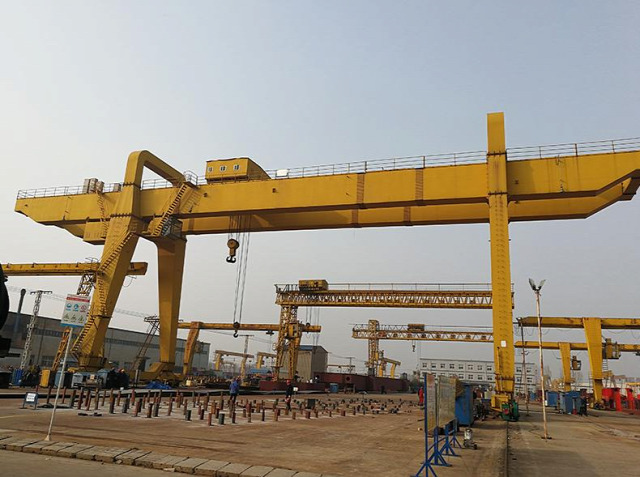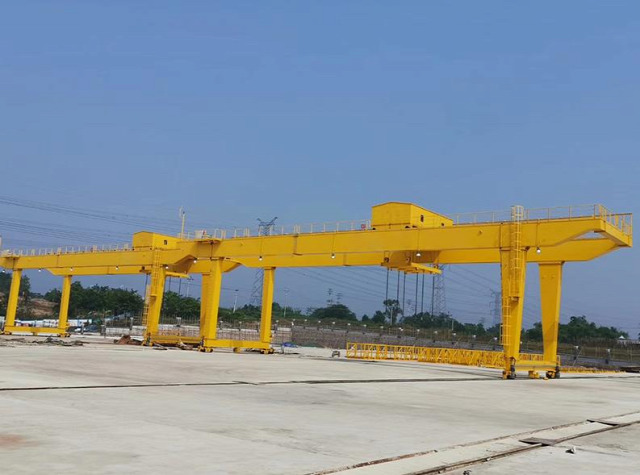Designing a gantry crane, especially a 30-ton model for outdoor applications, is a complex and detailed process that requires careful consideration of multiple factors, including load requirements, environmental conditions, and safety regulations. Outdoor gantry cranes are typically used in construction sites, port facilities, warehouses, and other heavy-duty industrial operations, where they help to move large and heavy materials efficiently. This article explores the key aspects of designing a 30-ton gantry crane for outdoor use, emphasizing structural integrity, materials, features, and safety.
1. Understanding the Role of a 30-Ton Gantry Crane
A 30 ton gantry crane for sale is designed to handle loads weighing up to 30 metric tons, which is essential in industries such as manufacturing, shipping, construction, and steel production. This crane provides the flexibility of lifting heavy materials such as steel beams, concrete, and machinery, which are often too large for traditional forklifts or other lifting equipment. The 30-ton capacity ensures that the crane can handle substantial weights, making it a key asset for outdoor construction projects, ports, and shipyards where heavy lifting is needed.

2. Site Conditions and Environmental Factors
Outdoor gantry cranes face harsh environmental conditions, such as fluctuating temperatures, humidity, high winds, and rain. These elements can impact the crane’s performance and longevity. Therefore, understanding the environmental factors at the installation site is essential for ensuring the crane’s durability and safety.
- Weather Resistance: Outdoor gantry cranes need to be built with weather-resistant materials that can withstand harsh conditions such as rain, snow, and extreme heat. Special coatings or materials like galvanized steel can be used to resist corrosion and maintain the crane's structural integrity.
- Wind Considerations: Since outdoor cranes are exposed to wind, designing the crane with reinforced components that can resist high wind speeds is critical. A crane’s stability under windy conditions is particularly important when operating at full load.
- Temperature Extremes: Cold or hot climates can impact crane performance. Materials used in the crane must be able to function in extreme temperatures without becoming brittle or weakened. For example, materials like low-temperature steel can be chosen for operations in cold climates, while heat-resistant components are vital in hot conditions.
- Rain and Moisture: Given that the crane will be exposed to rain and humidity, corrosion resistance is paramount. Paint coatings, galvanized finishes, or stainless steel can prevent rust and degradation from moisture exposure.
3. Structural Design
The structural design of a 30-ton gantry crane must ensure the crane is capable of handling heavy loads without compromising safety. Several critical factors contribute to a sound structural design:
- Material Selection: The materials used to build the crane's components must be strong, durable, and resistant to environmental degradation. Steel is typically the preferred material for gantry cranes due to its high strength-to-weight ratio, but the type of steel and protective coatings must be chosen based on the environmental conditions at the installation site.
- Beam and Support Framework: The crane’s main beams (also known as girders) and support framework must be designed to withstand both the load weight and dynamic forces that occur during crane operation, such as shock loading and sway. These beams need to be strong enough to support the 30-ton load but also lightweight enough to maintain ease of movement.
- Legs and Wheels: The legs and wheels of the gantry crane must be designed to provide stable support while allowing the crane to move along tracks or in a mobile configuration. When designing the legs, the weight distribution and load-bearing capacity should be calculated to prevent tipping or uneven loading. The wheels should also be capable of handling the terrain and should be designed with a durable material, such as rubber, for easy maneuvering across uneven ground.
- Bracing and Reinforcement: To enhance stability, additional bracing and reinforcement elements should be incorporated into the design to prevent deformation under heavy loads. The bracing should also be designed to accommodate any lateral forces from wind or other environmental impacts.

4. Lifting Mechanism and Components
The lifting mechanism of the gantry crane is the heart of its operation. This involves several critical components that must be carefully designed to ensure safe and efficient lifting.
- Hoist: The hoist mechanism, which includes the motor, drum, wire rope or chain, and hook, is responsible for lifting and lowering the load. A 30-ton gantry crane will require a powerful hoist system designed to lift loads up to 30 tons. The hoist should be equipped with an overload protection system, as well as a braking system to safely lower loads in case of an emergency.
- Lifting Speed and Control: The lifting speed of the crane must be adjustable to allow precise placement of loads. For outdoor applications, especially in construction sites or manufacturing plants, cranes need to move materials efficiently but without compromising safety. Variable speed controls should be incorporated to adjust the speed as needed depending on the load and task at hand.
- Remote Control and Operator Station: The crane’s control system must allow the operator to move the crane with precision and ensure safety during operation. For outdoor cranes, remote control options provide greater flexibility, allowing the operator to move the crane from a safe distance. Additionally, the crane should be equipped with an easy-to-use operator station, ensuring that the operator can easily control all crane movements.
5. Mobility and Ground Clearance
Outdoor gantry cranes often require mobility, especially if they need to move across a construction site or between work areas. The design must allow for easy movement while maintaining stability. Key considerations include:
- Track System: Some outdoor gantry cranes are mounted on rails, which allow for smooth movement across a designated path. The design of the track system must accommodate the weight of the crane and the terrain. If the crane is designed to be mobile (trackless), heavy-duty wheels or tires will be required to support the crane’s load and ensure smooth operation.
- Ground Clearance: The ground clearance of the crane should be sufficient to avoid obstacles such as rocks, debris, or uneven ground that could impede the crane’s movement. It also ensures that the crane can lift objects without obstruction.
6. Safety Features
Safety is always a top priority in crane design. For a 30-ton gantry crane, several safety features must be integrated to prevent accidents and ensure smooth operation.
- Limit Switches and Overload Protection: Limit switches prevent the crane from exceeding its maximum lifting height or moving beyond its intended range. Overload protection mechanisms prevent the crane from lifting more than the rated load, which could lead to damage or failure.
- Emergency Stop Buttons: Emergency stop buttons should be installed at strategic points on the crane to allow the operator to halt operations in case of a malfunction or safety hazard.
- Anti-Sway Technology: Anti-sway technology helps reduce swinging of the load during transportation. This is especially important in outdoor environments where wind can cause the load to sway, creating potential hazards.
7. Maintenance and Durability
For a gantry crane to serve efficiently in an outdoor environment, regular maintenance is necessary. The design should allow easy access to key components such as the hoist, motors, and wheels for inspection and repairs. Furthermore, all materials should be selected to ensure that the crane can withstand constant outdoor exposure without premature wear.
Conclusion
Designing a 30-ton gantry crane for outdoor use involves careful planning and attention to various critical factors such as environmental conditions, structural integrity, lifting mechanisms, mobility, and safety. Ensuring the crane’s durability, efficiency, and safety is crucial for its successful operation in outdoor environments. With the right materials, features, and design considerations, a 30-ton gantry crane can handle heavy-duty lifting operations in challenging outdoor conditions, providing a valuable tool for industries like construction, manufacturing, and shipping.

